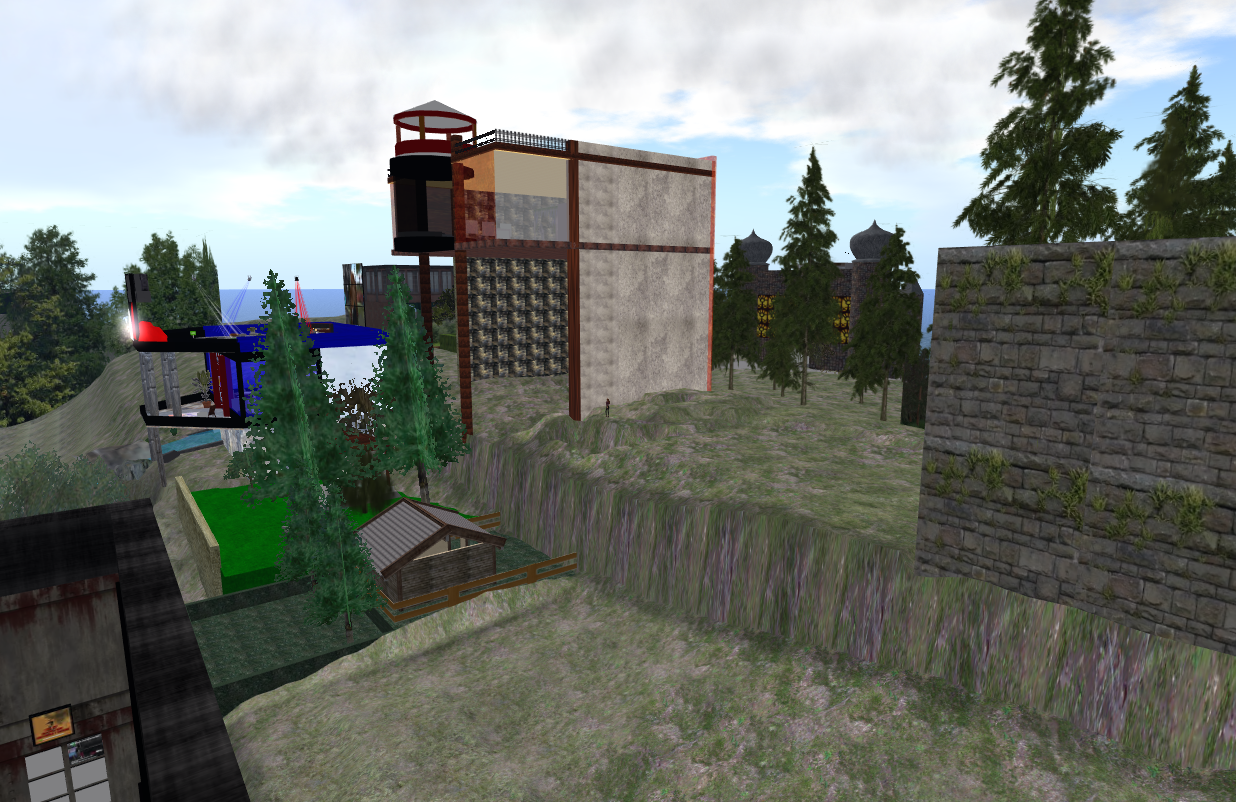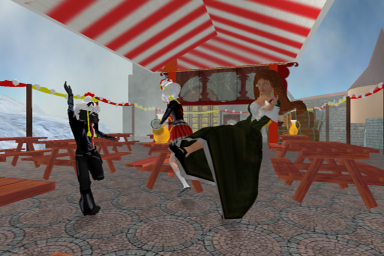The Freebie Generation vs. The Hundred Thousand
Market changes, and those adapting first will be the ones reaping the benefits — even if only short term, if they happen to adopt a suicidal strategy. Nevertheless, this was exactly what happened in SL, although we are only noticing its effects in mid-2008.
Once established service and content providers in SL understood that the age of newbie exploitation was over, a new model had to be devised. The dilemma was that newbies didn’t have money, so they would be unable to spend it. So the tentative answer was to “get them some money”. Money trees, where a community (usually a business community, but not always) contributes a bit to make the newbies slightly more wealthy and allow them the joys of shopping, was one of the earliest strategies. They were often placed by shopping mall owners, desperate to make the newbies come over and spend some money. Now you could look at money trees like a type of “income tax” on mall shop owners: you’d give a bit away from your profits, and expect that they shop at your mall (since it’s nearby). While you might not get much in return — after all, your monetary contribution could be used by a newbie to buy something at the shop across the mall — it looked like it was “better than nothing” (ie. newbies not even coming to the mall at all; what was the point anyway, if they had no money to shop?). You could always hope that a few would be lured by the money trees and buy some L$ at the GOM (or later at the LindeX), or even — miraculously — became Premium Accounts and returned to shop regularly.
The strategy didn’t work well, and the reason is simple to understand: the overall money-making community in SL was unable to replace the giant mint-making machine that is Linden Lab. Put into other words, there was no way to organise things overnight so that all Basic Accounts would get a weekly stipend of L$50 paid by the service and content providers. You can’t “organise” such a grid-wide system without some form of government; and since the dawn of SL, any form of government (except for LL) has always been anathema to talk about, so this wouldn’t work in the medium term, much less on the long run.
But the shops and malls and land rentals didn’t disappear back in 2006. In fact, they continued to grow and grow. Why?
The clever service providers in SL understood that the newbies weren’t a business opportunity any more. In fact, the only interesting class spending money in SL to sustain the economy were other service providers. Put it very bluntly, SL became a typical Third World economy, where money transactions only occur at the top level of the pyramid, but the lower levels — the worthless, money-less rabble of Basic Account residents — are pretty much ignored. They’re outside the economy since they’re not consumers any more.
For them, content creators started to give away freebies.
It actually made a lot of sense. Low-quality or old products did not fetch a market in the L$500 price range, the one Premium Accounts and service providers not only could afford, but would gladly do so, if the content was good enough. Similarly, nobody getting a stipend of L$500/week would wish to pay L$50/week to live in an apartment tower for newbies with the problems of chat range and parcel media issues. For L$500/week you wish your own isolated parcel, preferably with a nice prefab McMansion on top of it.
Service providers thus adjusted their offerings. They created apartment towers for newbies, often for zero rent (and zero quality) — while creating fancy neighbourhoods for the Premium Accounts willing to spend their stipends there, away from the rabble. Content creators gave away last year’s fashion, while focusing on L$500 outfits for the ones that could afford it. So basically the economy worked for a class composed solely of Premium Accounts and service providers — the ones that effectively spend money in SL, and the only ones now that are interesting to attract.
Suddenly the anxiety of capturing newbies as soon as possible grew less important. Instead, service providers had to attract the attention of clients with money in their pockets. And here the strategy was simple: after getting rid of almost every other metric in SL (like ratings), the last one available was traffic, and the “green dot effect” (people naturally gravitate to places where other people already are, since it looks like “something is happening there”). This is what I call the camping chair era — an economy based on the perceived popularity of a place (since there is just one metric, traffic, that determines ranking on the Search engine; and just one visual way to identify popular areas on the Map, green dots). All tricks to artificially raise the perceived popularity have, of course, been successfully exploited. Camping chairs and the tactical flashlight also have the nice side-effect that at least a few of those persistent campers, technically part of the uninteresting level of the economy pyramid (the 90% that never put any money in SL, and have no visible talent, skills, or time to offer products and services), might even gather a few L$ to be able to occasionally buy something nice. As regular consumers, they’re uninteresting; as a means to raise brand awareness artificially through traffic, they’re excellent.
Self-imposing a Third World economy in SL might disgust some of us, but it’s theoretically a valid long-term strategy. After all, as long as there is regular spending from a slice of society, the economy is happy. It doesn’t need to be over-reaching. Also, without a government (and I’m afraid I’m repeating myself), there is really no way to provide all those zero-Linden-spenders with any alternatives, since that would require global (ie. grid-wide) coordination.
We don’t need to feel sorry for them, though. Almost all without exception do not live in dare conditions in RL, so this is not a social issue like many have embraced in the past (“Help the newbies! Sponsor our charity to give every poor newbie a place to live in!”). People don’t spend money in SL by choice, not because they’re really poor. After all, they have wonderful computers with Internet access, and for a cup of coffee at Starbucks you can get quite a nice outfit on the most fashionable shops in SL! Barring a few exceptions of truly impoverished and hungry, starving people (I’ve met a few in my four years in SL), almost all of them simply don’t wish to spend anything out of their RL pockets. If they wished, they’d do it pretty easily.
Converting Basic Accounts into Premium Accounts, however, has been one of LL’s major failures. So much that they’re considering to drop the whole issue — like they did with the “Lifetime accounts” not long after SL was opened in June 2003. After all, looking to the statistics, the number of Premium Accounts has risen to close to hundred thousand and totally stagnated.
New residents will never become Premium. Why should they? The ones willing to spend money in SL will simply go to the LindeX, buy some land on a private island (since they don’t need to be Premium to do that) and enjoy exactly the same benefits as a Premium Account. In fact, for the same amount of money, you get a better deal at the LindeX anyway. So current Premium Account residents will not feel a big loss of this “status” anyway; they are part of the group that already is willing to spend money in SL (although paying monthly, quarterly, or yearly to Linden Lab) anyway, they will quickly switch to using the LindeX more regularly, which they most certainly have already used.
At this stage, I have to formulate my own theory though. Based on my own perception of the numbers, I boldly claim that the number of people willing to spend money in SL is about hundred thousand, and this number hasn’t changed since at least early 2007.
The second bold claim is perhaps even more surprising. The number of service providers (content creators, event hosters, and land managers) is about hundred thousand. This basically means that about one in ten active users is a producer of content, while the remaining are pure consumers.
And the third bold claim is definitely shocking. This number will NOT change in the immediate future. Unless, of course, things change dramatically (which is always possible), but the change will be only a positive one, ie. more users in this group, not less.
The fourth claim is perhaps not so surprising then: The number of informed people in Second Life (those that read and write blogs or e-zines, participate actively in SL-related issues, work for RL companies providing content and services in SL, etc.) is about a hundred thousand.
And the fifth should not come as a surprise either: They are exactly the same people. Sure, I’ll allow a margin of error, of, say, 20-30% in either direction. But I’d say that it’s extremely likely — mmmh 95% or so — that if you’re reading this article, you’re very likely a Premium Account resident, or an owner of a private island (or a set of them), or a content/service provider (these are inclusive “or”s, so you can be all of those). If you’re none of those cases (ie. a Basic Account user who never spent a single cent in SL, live from freebies, and never organised a single event in SL…), you’re probably writing regularly about SL.
“Extraordinary claims require extraordinary proof”, as any good scientist would immediately demand, so I’ll have to back up those claims with some data. But I’m going to leave that for a further chapter. Let’s examine the consequences first.




